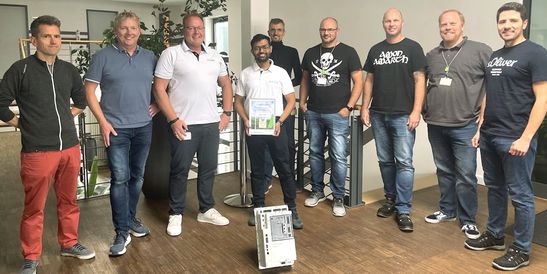Hardware-in-the-loop vs. hall test bench: 2 test benches, 2 realities
- Windenergy
- Drive Technology
- 24.7.2025
- Reading Time: {{readingTime}} min

Contents
Software tests accompany the pitch system from the very beginning
In our blog article "Software Testing for Pitch Systems: Basis for TÜV Certification", we addressed the safety-critical tasks that pitch systems perform in wind turbines – such as emergency shutdown in the event of a grid fault or controlled braking of the rotor. Intensive tests are required for these functions to work reliably and in accordance with standards. But how do you test realistically, efficiently and reproducibly?
The answer lies in the comparison: classic system test bench versus hardware-in-the-loop (HIL) testing. Two approaches, two worlds – with clear differences.
System test benches: Close to reality – and to the limits

Imagine a system test bench like a small wind turbine in a laboratory: Everything that is installed in the real pitch system – servo controller, motor, gearbox, encoder, load machines, – is available "in real life", including real temperature and load conditions. Sounds impressive? It is. But it comes with a price. Even the assembly requires considerable space, as all components of the pitch system must be accommodated. During operation, high noise and heat emissions are also generated, especially with dynamic load profiles and endurance runs, which not only puts a strain on the working environment, but also places additional demands on infrastructure and cooling.
Another critical point are safety-related risks. Moving parts, electrical operating ranges, and rotating masses make operations potentially dangerous, requiring extensive protective measures for personnel and equipment. The test bench must be regularly adapted to different variants – for example, if different servo controllers, motors or energy storage concepts are to be tested. This leads to recurring set-up times, high logistical effort and the need to keep and store many hardware components. From an economic point of view, the system test bench is cost-intensive: In addition to the initial investment, there are ongoing expenses for maintenance, spare parts and test personnel. The potential for errors increases especially in manual test processes, because different operators, non-automated logging and a lack of repeatability have a direct effect on test quality and significance – an aspect that is particularly critical for safety-relevant functions.
What speaks against system test benches
- Space wasters: Large plants need large halls.
- Cost-intensive: The more variants are to be tested, the higher the material and conversion costs.
- Hazardous: Moving parts, potential hazard from electrical systems, fire or injury risks – safety is complex.
- Inflexible: Testing under extreme conditions? Difficult. Repeatability? Not always possible.
- Personnel costs: Every test run requires personnel – and that adds up.
Now imagine this…
Do you want to test all the components of a pitch system without physically building them? Is a wide range of temperatures to be simulated that can never be reliably generated? Do you want to provoke errors – without any danger or hardware wear? HIL makes it possible.

HIL testing: Real-time simulation instead of huge halls with a lot of noise and even more resources
In contrast to the physical system test bench, the HIL test procedure is based on a real-time simulation of the system environment. In this process the control electronics, such as the servo drive of a pitch system, are connected to a digital model of its physical environment. This model runs on specialized simulation hardware, such as an FPGA-based HIL system, like the dSPACE HIL2. The real signals are guided at the small signal level, which means that all tests can be carried out completely tension-free and without mechanical movement.
This methodology offers several decisive advantages: The entire test bench is compact, requires significantly less space and does not cause any disturbing noise or significant heat generation. This significantly reduces the infrastructural requirements. At the same time, the risk for operating personnel is eliminated, as there are no dangerous voltages or rotating components. Critical operating points – such as overspeed, mains undervoltage or thermal limits – can be simulated safely, which enables a test depth that would be difficult or impossible to achieve with a physical setup.
Another key advantage is the flexibility and scalability of the HIL approach. New system variants, as commonly found with different customer requirements, only require an adjustment in the simulation model – no hardware modifications or set-up times. All tests can be automated, documented and repeated as often as desired, which ensures the comparability of the results and supports standard-compliant, reproducible verification according to the V-model. The approach is also convincing from an economic point of view: Lower material costs, minimal set-up effort and reduced personnel requirements lead to a significant reduction in test costs.
An example calculation:

HIL thus enables controlled, secure and cost-efficient validation of safety-critical functions – ideal for applications where availability, certifiability and test depth are top priorities.
Advantages of HIL testing at a glance:
- Safety gain: No high-voltage operation, no rotating parts – critical scenarios can be tested risk-free.
- Room and energy efficiency: Small signal technology drastically reduces space requirements, noise and energy consumption.
- Test depth without limits: Extreme conditions such as network errors, temperature limits or anomalies can be reproduced as required.
- Cost efficiency: No rebuilds, no spare parts, no warehousing – but fast iterations and automation.
- Scalability & Repeatability: New Variants? Simply extend the simulation model. Every test runs identically – perfect for certifications.
Result
While the system test bench can do a lot, it quickly reaches its limits in terms of safety, flexibility and cost-effectiveness. HIL testing is the consistent answer to the requirements of modern development and validation.
For a deep dive into our understanding of HIL, you can download our whitepaper Efficient Testing of Embedded Software on System Test Benches with Variable Test Environment here. It shows how you can significantly reduce your testing costs by using HIL while ensuring the reliability of your pitch systems.








